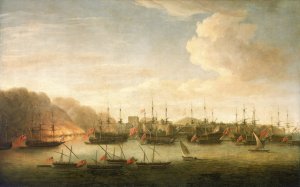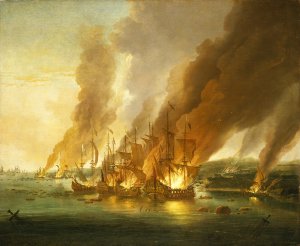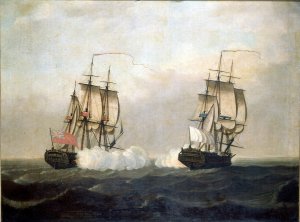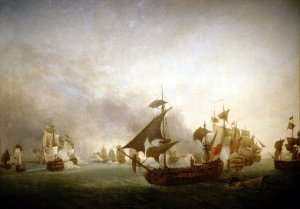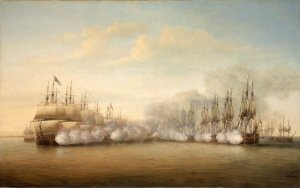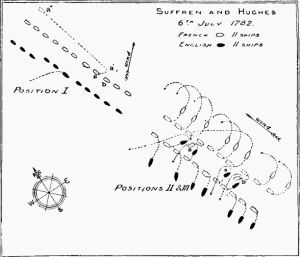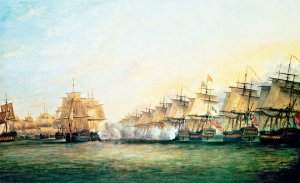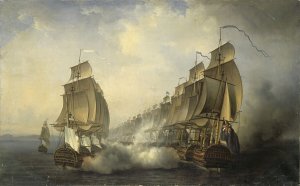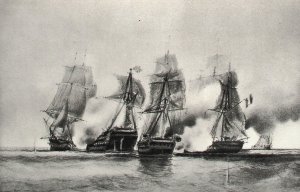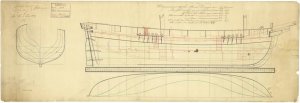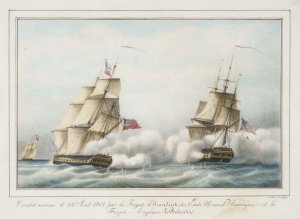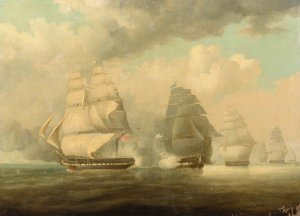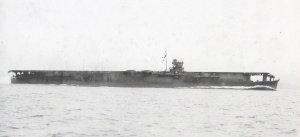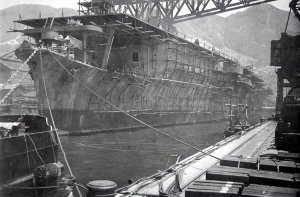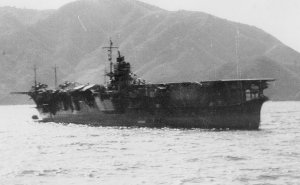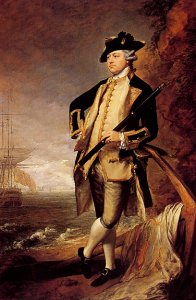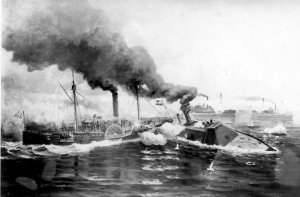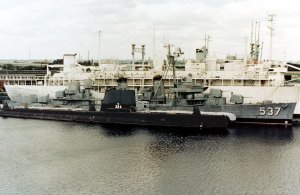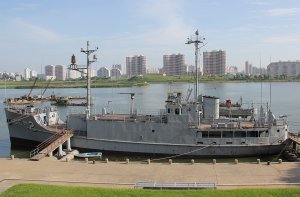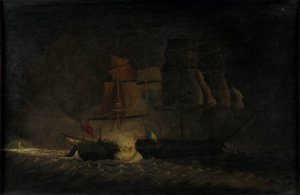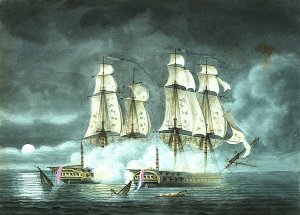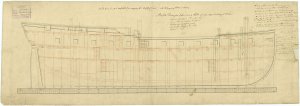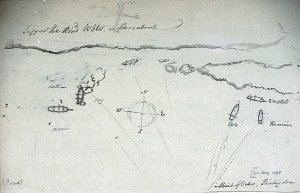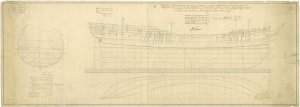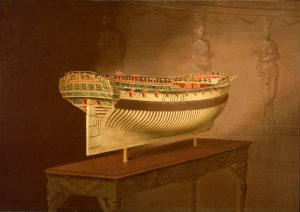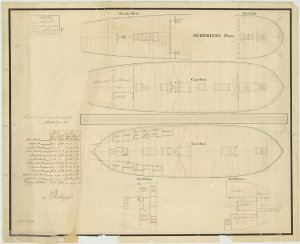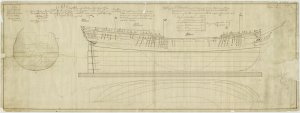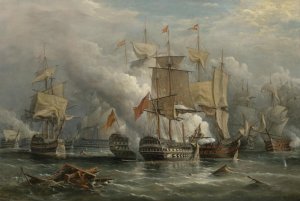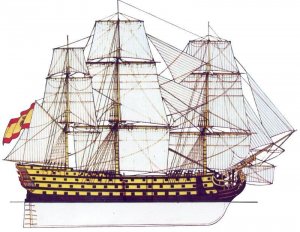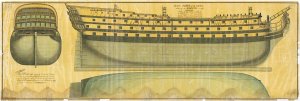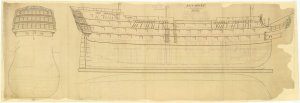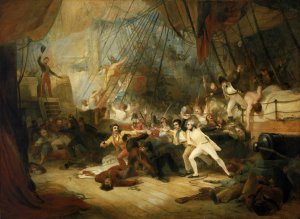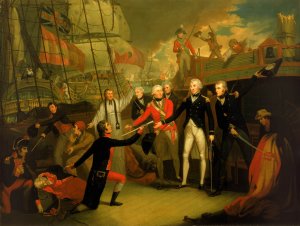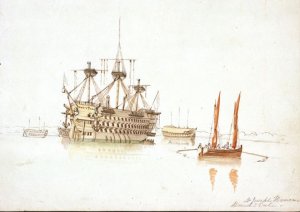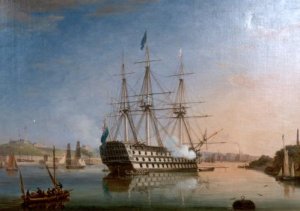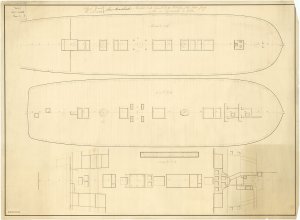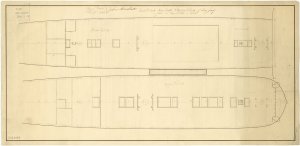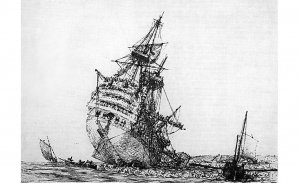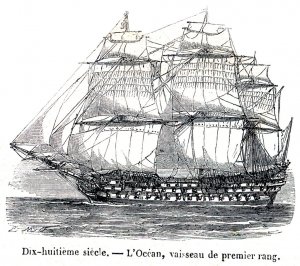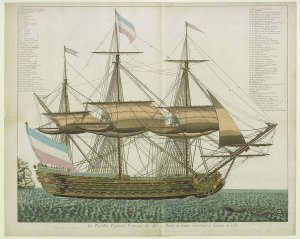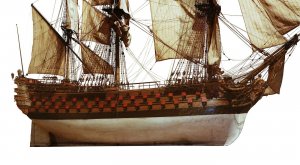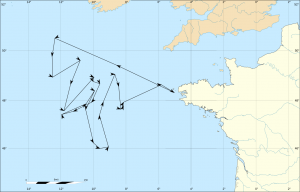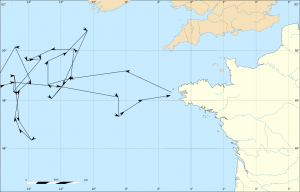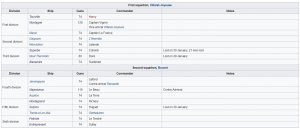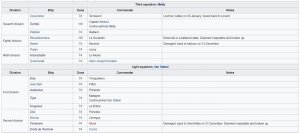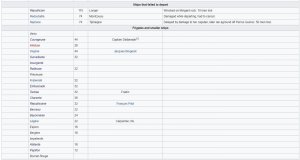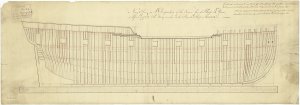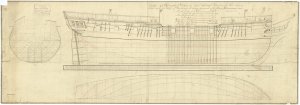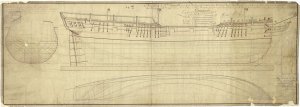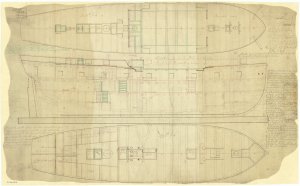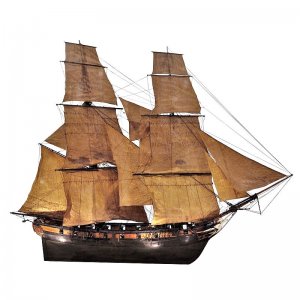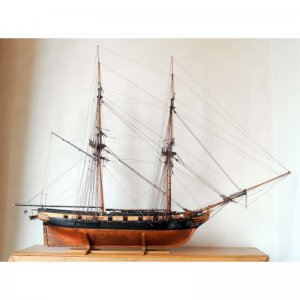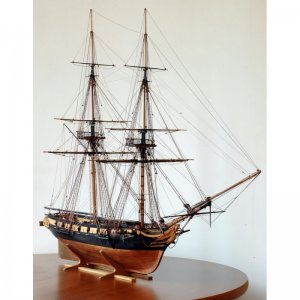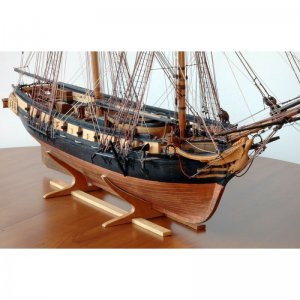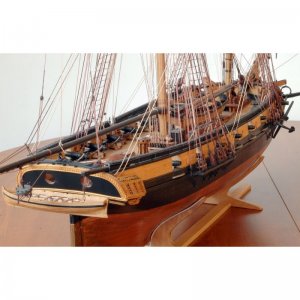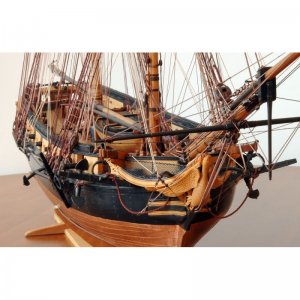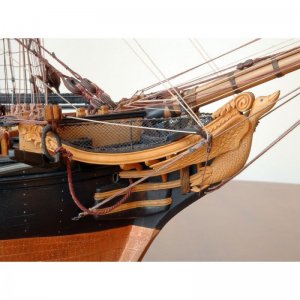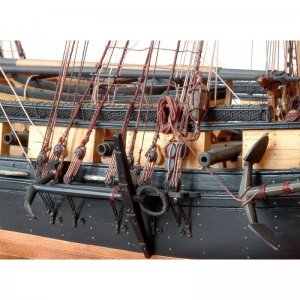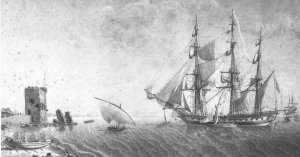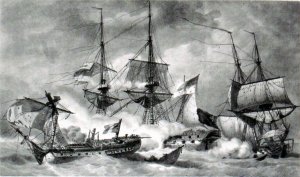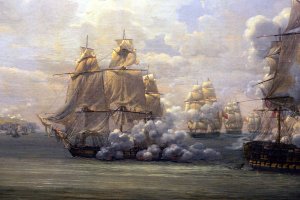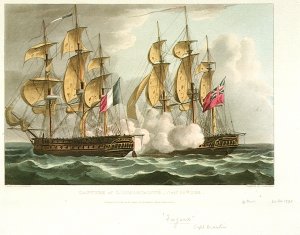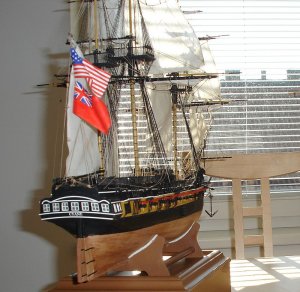Today in Naval History - Naval / Maritime Events in History
24 December 1789 - HMS Guardian (en flute), Lt. Edward Riou, hit an iceberg.
Whilst laden with stores for the new settlement at Port Jackson struck an invisible, underwater part of an iceberg and her stern swung round, knocking off the rudder and badly damaging the stern frame. Water-logged and supported by casks in the hold she limped into Table Bay on 21 February 1790.
HMS Guardian was a 44-gun
Roebuck-class fifth-rate two-decker of the
Royal Navy, later converted to carry stores. She was completed too late to take part in the
American War of Independence, and instead spent several years laid up
in ordinary, before finally entering service as a store and convict transport to Australia, under Lieutenant
Edward Riou. Riou sailed the
Guardian, loaded with provisions, animals, convicts and their overseers, to the
Cape of Good Hope where he took on more supplies. Nearly two weeks after his departure on the second leg of the journey, an
iceberg was sighted and Riou sent boats to collect ice to replenish his water supplies. Before he could complete the re-provisioning, a sudden change in the weather obscured the iceberg, and the
Guardian collided with it while trying to pull away. She was badly damaged and in immediate danger of sinking. The crew made frantic repair attempts but to no apparent avail. Riou eventually allowed most of the crew to take to the
Guardian's boats, but refused to leave his ship. Eventually through continuous work he and the remaining crew were able to navigate the ship, by now reduced to little more than a raft, back to the Cape, a nine-week voyage described as 'almost unparalleled'. Riou ran the
Guardian aground to prevent her sinking, but shortly afterwards a hurricane struck the coast, wrecking her. The remains were sold the next year, in 1790.
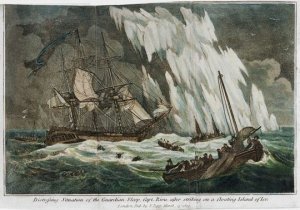
Distressing situation of the Guardian sloop, Capt. Riou, after striking on a floating Island of ice
Construction and commissioning
She was ordered from Robert Batson,
Limehouse on 11 August 1780 and was laid down in December that year.
[1] Guardian was launched on 23 March 1784, too late to see service in the
American War of Independence and was instead fitted out at
Deptford Dockyard for ordinary.
[1][2] The builder was paid £12,322.12.11d for her construction, with the Admiralty paying another £4,420 to fit her out. After five years spent laid up she was fitted out at
Woolwich in 1789 to serve as a store and convict transport, commissioning under Post-Captain
Edward Riou in April.

Scale: 1:48. Plan showing the body plan with stern board outline, sheer lines with inboard detail, longitudinal half - breadth for Guardian (1784), a 44 - gun Fifth Rate two - decker as built at Limehouse by Mr. Batson. Note: single level of stern and quarter deck galleries.
Class and type:
44-gun Roebuck-class two-decker fifth rate
Tons burthen: 896 33/94
bm
Length:
- 140 ft (42.7 m) (overall)
- 115 ft 6 in (35.2 m) (keel)
Beam: 38 ft 2.5 in (11.6 m)
Depth of hold: 16 ft 4 in (4.98 m)
Propulsion: Sails
Sail plan :
Full rigged ship
Complement: 300
Armament:
- Upper deck: 22 x 9pdrs
- Lower deck: 20 x 18pdrs
- Forecastle: 2 x 6pdrs
Voyage to Australia
Riou was tasked with delivering the stores consisting of seeds, plants, farm machinery and livestock, with a total value of some £70,000, and convicts to the British settlement at
Botany Bay.
[3] At least some of the plants and seeds were provided by
Hugh Ronalds, a nurseryman in
Brentford. Also aboard the
Guardian was a young midshipman named
Thomas Pitt, the son of politician
Thomas Pitt, and nephew of Prime Minister
William Pitt.
With over 300 people aboard his ship, Riou left
Spithead on 8 September, and had an uneventful voyage to the
Cape of Good Hope, where he arrived on 24 November and loaded more livestock and plants. After completing his re-provisioning Riou sailed from the Cape in mid-December, and picking up the
Westerlies began the second leg of his voyage to
New South Wales. On Christmas Eve, twelve days and 1,300 statute miles (2100 km) after his departure from the Cape, a large
iceberg was spotted at
44°S 41°ECoordinates:
44°S 41°E, and Riou decided to use the ice to replenish his stocks of fresh water, that were quickly being depleted by the need to supply the plants and animals he was transporting.
Riou and the iceberg
Riou positioned himself near the iceberg, and despatched boats to collect the ice. By the time the last boats had been recovered night had fallen, when a sudden fogbank descended, hiding the iceberg from view. Riou found himself in a dangerous situation. Somewhere to leeward lay a large mass of ice, concealed in the darkness and fog. He posted lookouts in the bows and rigging, and began to edge slowly forward. After sometime the danger seemed to be past, and the iceberg left behind, when at 9 o'clock a strange pale glow was reported by the lookout in the bows. Riou ordered the helm to turn hard a starboard, turning into the wind as a wall of ice higher than the ship's masts slid by along the side. It briefly appeared that the danger had been avoided, but as she passed by the
Guardian struck an underwater projection with a sudden crash. Caught in a sudden gust of wind the ship reared up and swung about, driving the stern into the ice, smashing away the rudder, shattering her stern frame and tearing a large gash in the hull.
[6] Despite the seriousness of the situation Riou remained calm, using the sails to pull clear of the ice, and then taking stock of the damage.
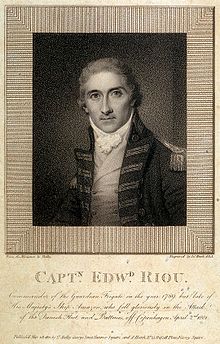
Engraving made in 1801 after Riou's death during the
Battle of Copenhagen; "Captn Edwd Riou Commander of the Guardian Frigate in the year 1789 but late of His Majesty's ship Amazon who fell gloriously in the Attack of the Danish Fleet and Batteries off Copenhagen 2 April 1801"
Now clear of the immediate danger of the ice, Riou found himself in a desperate situation. There was two feet of water in the hold and more was rushing in, while the sea was rising and a gale had sprung up. The pumps were manned, but could not keep up with the ingress of water, and by midnight there was 6 feet of water in the hold. At dawn on Christmas Day an attempt was made
to fother the hull by lowering an
oakum-packed
studding sail over the side to cover the gash in the hull and slow the flooding. This was temporarily successful and by 11 o'clock the pumps had been able to reduce the water to a level of 19 inches.
[6] The respite was short-lived, when the sail split under the pressure of the water and the water level began to rise again. At this a number of seaman requested permission to take to the ship's boats.
[6] Riou convinced them to stay, but another attempt to fother the hull with another sail failed when the sail immediately ripped.
By nightfall on 25 December the water in the hold had risen to 7 feet, and the ship was rolling violently, allowing water to pour over the ship's side. Riou ordered the stores, guns and livestock to be thrown overboard in an attempt to lighten the ship, but was injured when his hand was crushed by a falling cask while trying to clear the bread-room. By morning the next day the ship was settling by the stern, while the sails had been torn away in the gale. Again the seamen, this time joined by the convicts, requested to be allowed to take to the boats. Riou at last agreed to this, well aware that there were not enough boats for everyone, and announced 'As for me, I have determined to remain in the ship, and shall endeavour to make my presence useful as long as there is any occasion for it.'
'I have determined to remain in the ship'
While the boats were prepared, Riou wrote a letter to the
Secretary to the Admiralty;
Sir,
If any part of the officers or crew of the Guardian should ever survive to get home, I have only to say their conduct after the fatal stroke against an island of ice was admirable and wonderful in everything that related to their duties considered either as private men or on his Majesty's Service.
As there seems no possibility of my remaining many hours in this world, I beg leave to recommend to the consideration of the Admiralty a sister who if my conduct or service should be found deserving any memory their favour might be shown to her together with a widowed mother.
I am Sir remaining with great respect
Your ever Obedt & humble servt,
E. Riou
Riou gave the note to Mr Clements, the master of the
Guardian, who was given command of the launch. A total of 259 people chose to join the five boats, leaving Riou with sixty-two people; himself, three midshipmen, including Thomas Pitt, the surgeon's mate, the boatswain, carpenter, three superintendents of convicts, a daughter of one of the superintendents, thirty seamen and boys and twenty-one convicts. The
Guardian was nearly awash by now with 16 feet of water in the hold, but a bumping noise on the deck attracted attention, and on investigation was found to be a number of casks that had broken free and were floating in the hold, trapped under the lower gundeck. Realising that this was providing extra buoyancy Riou had the gun deck hatches sealed and caulked, while another sail was sent under the hull to control the flooding. Having now created a substitute hull out of his deck Riou raised what little sail he could and began the long journey back to land, with the pumps being continuously manned.
For nine weeks Riou and his small crew navigated the
Guardian, by now little more than a raft, across the 400
leagues to the Cape of Good Hope. The Cape of Good Hope was sighted on 21 February 1790, and whalers were despatched from
Table Bay to help the battered ship to safety. On 15 March Riou sent a letter from Table Bay expressing his intent to try reach
Saldanha Bay, there to moor close to the shore to preserve what he could of the vessel and cargo. The letter also included a list of the 61 men and one woman (Elizabeth Schafer, daughter of one of the Superintendents of Convicts) on board
Guardian.
A gale on 12 April drove
Guardian on the beach. The wreck was sold on 17 February 1791.
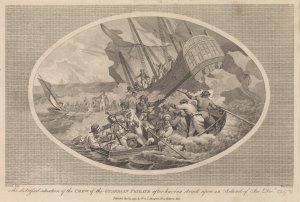
The Guardian, under Captain Edward Riou, was the first ship requisitioned to take vital supplies to support the ‘Botany Bay’ penal colony founded in 1788 by Commodore Arthur Philip, though in fact by then moved to Port Jackson (Sydney) , New South Wales. After leaving Cape Town she damaged her stern, rudder and bilge in collision with an iceberg on 23rd December 1789 and it was only owing to Riou's brilliant seamanship that she was able to make it back to Table Bay - those who insisted on taking to the lifeboats were not seen again and the Australian colony was left in serious hardship until resupply was possible. Most of the Guardian’s materials were saved when she was beached near Cape Town and later sent on. Riou died in 1801 commanding Nelson's frigates at the Battle of Copenhagen. This oval engraving shows the ship grounded on the iceberg, while some of the unfortunate crew and passengers abandon ship in treacherous conditions.
Aftermath
J. K. Laughton, writing in the
Dictionary of National Biography, described the voyage as 'almost without parallel'. Those who remained with the
Guardian were among the few survivors of the accident.
Of the boats sent out on 25 December only the launch, with 15 people, survived, having been rescued by a French merchant. The launch had witnessed the sinking of the
jolly-boat, before losing contact with the two
cutters and the long-boat.
The 21 convicts that survived went on to New South Wales. However, Riou's report of their conduct resulted in 14 of the convicts being pardoned. The remains of the
Guardian were sold on 8 February 1791.
The replacement cargo of European plants for New South Wales, arranged by Sir
Joseph Banks, was shipped in 1800 on
HMS Porpoise (1799).
Post-script
The loss of the
Guardian was used by
Patrick O'Brian as the basis for his novel
Desolation Island.
https://en.wikipedia.org/wiki/HMS_Guardian_(1784)